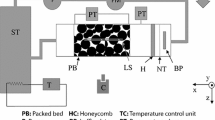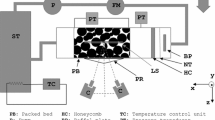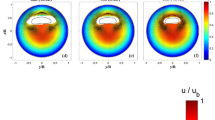Abstract
This paper presents results of an experimental study investigating the mean and temporal evolution of flow within the pore space of a packed bed overlain by a free-surface flow. Data were collected by an endoscopic PIV (EPIV) technique. EPIV allows the instantaneous velocity field within the pore space to be quantified at a high spatio-temporal resolution, thus permitting investigation of the structure of turbulent subsurface flow produced by a high Reynolds number freestream flow (Re s in the range 9.8 × 103–9.7 × 104). Evolution of coherent flow structures within the pore space is shown to be driven by jet flow, with the interaction of this jet with the pore flow generating distinct coherent flow structures. The effects of freestream water depth, Reynolds and Froude numbers are investigated.














Similar content being viewed by others
References
Adrian RJ (2007) Hairpin vortex organization in wall turbulence. Phys Fluids 19:041301. doi:10.1063/1.2717527
Adrian RJ, Christensen KT, Liu ZC (2000) Analysis and interpretation of instantaneous turbulent velocity fields. Exp Fluids 29(3):275–290. doi:10.1007/s003489900087
Arthur JK, Ruth DW, Tachie MF (2009) PIV measurements of flow through a model porous medium with varying boundary conditions. J Fluid Mech 629:343–374. doi:10.1017/S0022112009006405
Best JL, Kirkbride A, Peakall J (2001) Mean flow and turbulence structure in sediment-laden gravity currents: new insights using ultrasonic Doppler velocity profiling. In: McCaffrey WD, Kneller BC, Peakall J (eds) Particulate gravity currents, special publication of the international association of sedimentologists, vol 31. Blackwell Science, Oxford, UK, pp 159–172. doi:10.1002/9781444304275.ch12
Dierksheide U, Meyer P, Hovestadt T, Hentschel W (2002) Endoscopic 2D particle image velocimetry (PIV) flow field measurements in IC engines. Exp Fluids 33:794–800. doi:10.1017/S0022112009006405
Dybbs A, Edwards RV (1984) A new look at porous media fluid mechanics. Darcy to turbulent. In: Bear J, Corapcioglu MY (eds) Fundamentals of transport phenomena in porous media. Martinus Nijhoff Publisher, NATO ASI Series, Series E
Elkins CJ, Alley MT (2007) Magnetic resonance velocimetry: applications of magnetic resonance imaging in the measurement of fluid motion. Exp Fluids 43:823–858. doi:10.1007/s00348-007-0383-2
Forchheimer P (1901) Wasserbeweguing durch Boden. Z Ver Deutsch Ing 45:1782–1788
Goharzadeh A, Khalili A, Jørgensen BB (2005) Transition layer thickness at a fluid-porous interface. Phys Fluids 17:057102. doi:10.1063/1.1894796
Hart DP (2000) PIV error correction. Exp Fluids 29(1):13–22. doi:10.1007/s003480050421
Hassan YA, Dominguez-Ontiveros EE (2008) Flow visualization in a pebble bed reactor experiment using PIV and refractive index matching techniques. Nucl Eng Des 238(11):3080–3085. doi:10.1016/j.nucengdes.2008.01.027
Heenan AF, Matida E, Pollard A, Finlay WH (2003) Experimental measurements and computational modeling of the flow field in an idealized human oropharynx. Exp Fluids 35(1):70–84. doi:10.1007/s00348-003-0636-7
Hlushkou D, Tallarek U (2006) Transition from creeping via viscous-inertial to turbulent flow in fixed beds. J Chromatogr 1126:70–85. doi:10.1016/j.chroma.2006.06.011
Huang AYL, Huang MYF, Capart H, Chen R-H (2008) Optical measurements of pore geometry and fluid velocity in a bed of irregularly packed sphere. Exp Fluids 45:309–321. doi:10.1007/s00348-008-0480-x
Jolls KR, Hanratty TJ (1966) Transition to turbulence for flow through a dumped bed of spheres. Chem Eng Sci 21:1185–1190
Khalili A, Basu AJ, Pietrzyk U, Raffel M (1999) An experimental study of recirculating flow through fluid-sediment interfaces. J Fluid Mech 383:229–247
Klar M, Jehle M, Jahne B, Detert M, Jirka GH, Kohler HJ, Wenka T (2004) Simultaneous 3-D PTV and micro-pressure sensor equipment for flow analysis in a subsurface gravel layer. In: Greco M, Carravetta A, Della Morte R (eds) Proceedings of the 2nd international conference on fluvial hydraulics. Napoli, Italy, pp 703–712
Masuoka T, Takatsu Y, Inoue T (2002) Chaotic behavior and transition to turbulence in porous media. Nanoscale Microscale Thermophys Eng 6(4):347–357. doi:10.1080/10893950290098377
Mickley HS, Smith KA, Korchak EI (1965) Fluid flow in packed beds. Chem Eng Sci 20:237–246
Morad MR, Khalili A (2009) Transition layer thickness in a fluid-porous medium of multi-sized spherical beads. Exp Fluids 46:323–330. doi:10.1007/s00348-008-0562-9
Moroni M, Cushman JH (2001) Statistical mechanics with three-dimensional particle tracking velocimetry experiments in the study of anomalous dispersion. II. Experiments. Phys Fluids 13:81. doi:10.1063/1.1328076
Nield DA, Bejan A (2006) Convection in porous media, 3rd edn. Springer, New York. ISBN 978-0387-29096-6
Packman AI, Salehin M, Zaramella M (2004) Hyporheic exchange with gravel beds: basic hydrodynamic interactions and bedform-induced advective flows. J Hydraul Eng 130(7):647–656. doi:10.1061/(ASCE)0733-9429(2004)130:7(647)
Pokrajac D, Manes C (2009) Velocity measurements of a free-surface turbulent flow penetrating a porous medium composed of uniform-size spheres. Transp Porous Med 78:367–383. doi:10.1007/s11242-009-9339-8
Pokrajac D, Manes C, McEwan I (2007) Peculiar mean velocity profiles within a porous bed of an open channel. Phys Fluids 19:098109. doi:10.1063/1.2780193
Raffel M, Willert CE, Wereley ST, Kompenhans J (2007) Particle image velocimetry: a practical guide, 2nd edn. Springer, Berlin
Reeves M, Lawson NJ (2004) Evaluation and correction of perspective errors in endoscopic PIV. Exp Fluids 36(5):701–705. doi:10.1007/s00348-003-0746-2
Seguin D, Montillet A, Comiti J, Huett F (1998) Experimental characterization of flow regimes in various porous media-II: Transition to turbulent regime. Chem Eng Sci 53(22):3897–3909. doi:10.1016/S0009-2509(98)80003-1
Soloff SM, Adrian RJ, Liu Z-C (1997) Distortion compensation for generalised stereoscopic particle image velocimetry. Meas Sci Technol 8:1441–1454. doi:10.1088/0957-0233/8/12/008
Stoesser T, Rodi W (2007) Large eddy simulation of open-channel flow over spheres. High Performan Comput Sci Eng 4:321–330. doi:10.1007/978-3-540-36183-1_23
Tani N, Kondo H, Mori M, Hishida K, Maeda M (2002) Development of fiberscope PIV system by controlling diode laser illumination. Exp Fluids 33:752–758. doi:10.1007/s00348-002-0517-5
Wernet MP (2000) Development of digital particle imaging velocimetry for use in turbomachinery. Exp Fluids 28(2):97–115. doi:10.1007/s003480050015
Westerweel J (1994) Efficient detection of spurious vectors in particle image velocimetry data. Exp Fluids 16:236–247. doi:10.1007/BF00206543
White BL, Nepf HM (2007) Shear instability and coherent structures in shallow flow adjacent to a porous layer. J Fluid Mech 593:1–32. doi:10.1017/S0022112007008415
Yevseyev AR, Nakoryakov VE, Romanov NN (1991) Experimental investigation of a turbulent filtrational flow. Int J Multiphase Flow 17(1):103–118. doi:10.1016/0301-9322(91)90073-C
Zachos A, Kaiser M, Merzkirch W (1996) PIV measurements in multiphase flow with nominally high concentration of the solid phase. Exp Fluids 20:229–231. doi:10.1007/BF00190280
Acknowledgments
We thank the UK Natural Environment Research Council for funding this work (NE/E006884/1). All experiments were undertaken in the Ven Te Chow Hydrosystems Laboratory, University of Illinois, and we thank Professor Marcelo Garcia for allowing access to this facility, and Professor Kenneth Christensen for providing part of the PIV equipment. Stephan Kallweit of Intelligent Laser Applications (ILA GmbH) supplied the endoscopes and much useful advice on their application, for which we are very grateful.
Author information
Authors and Affiliations
Corresponding author
Electronic supplementary material
Below is the link to the electronic supplementary material.
Online Resource 1 Sequence of images of instantaneous flow fields showing the evolution of flow driven by a downstream jet leading to formation of a vortical pathway. Supplementary material 1 (AVI 22777 kb)
Online Resource 2 Sequence of images of instantaneous flow fields showing the evolution of flow triggered by a spanwise jet leading to formation of a large vortical structure, whose evolution is driven by fluid motion that is first downstream and then upstream. Supplementary material 2 (AVI 6537 kb)
Appendix 1: Uncertainty analysis
Appendix 1: Uncertainty analysis
The uncertainty (\( \sigma_{\text{U}} \)) of each EPIV instantaneous velocity measurement (valid for both U x and U y ) can be evaluated as the combination of the systematic errors of each submeasurement. The uncertainty (\( \sigma_{{\overline{\text{U}} }} \)) of the time-averaged velocity \( \overline{{U}} \) can be estimated as the statistical uncertainty of the time history sample.
1.1 Systematic error
The flow velocity at position x for time t can be defined as:
where \( \Updelta S = \left| {X_{t + 1} - X_{t} } \right| \) represents the particle displacement measured on the image and δu expresses the uncertainty of the velocity introduced by specific experimental assumptions (i.e. negligible particle lag and 3D effects). The total standard uncertainty of the velocity (\( \sigma_{\text{U}} \)) can be evaluated by combining all the individual uncertainties of the submeasurements as:
where \( \sigma_{{g_{i} }} \) represents the standard uncertainty of the physical quantities g i , and s \( \left( {\frac{\partial u}{{\partial g_{i} }}} \right)^{2} \) represents the sensitivity factors. The factors considered in the uncertainty analysis are: (1) the magnification factor (α m), which is affected by the dot spacing on the calibration target, measurement of the dot spacing, calibration of the target angle and the gap between the measurement plane and target; (2) the displacement (Δs), which can be affected by possible fluctuations in the laser sheet, view angle, sub-pixel accuracy and mismatching errors; (3) the time interval (Δt) that may be affected by synchronisation errors and (4) the velocity lag (δu) that is influenced by the characteristics of the tracer particles and flow.
On the basis of the analysis described above, the uncertainty \( \sigma_{\text{U}} \), which for this application was non-uniform over the field of view due to the different levels of optical distortion, was estimated to be in the range of 1–3%.
1.2 Uncertainty of the mean values
This analysis is based upon the assumption that no systematic error is present in the velocity data and the representativeness of the mean value can be evaluated statistically. If the sources of error are assumed to be independent, each value of a sample U x(i, j) (or U y(i, j)) can be considered as a random variable, R. Under these assumptions, the uncertainty \( \sigma_{{\overline{\text{U}} }} \), which measures the statistical stability of the estimated mean values, can be estimated by computing the standard deviation, S, of the velocity magnitude (derived through computing the components by Eqs. 2 and 3) and introducing a statistical analysis approach where \( \sigma_{{\overline{\text{U}} }} \) is proportional to the ratio \( S/\sqrt n \). Using the probability function concept and introducing a confidence interval of 95%, the mean flow estimated with a sample of 500 realizations allows an estimate of both the vertical and horizontal components of the velocity field with an uncertainty no larger than 2.5% of the sample mean.
Rights and permissions
About this article
Cite this article
Blois, G., Sambrook Smith, G.H., Best, J.L. et al. Quantifying the dynamics of flow within a permeable bed using time-resolved endoscopic particle imaging velocimetry (EPIV). Exp Fluids 53, 51–76 (2012). https://doi.org/10.1007/s00348-011-1198-8
Received:
Revised:
Accepted:
Published:
Issue Date:
DOI: https://doi.org/10.1007/s00348-011-1198-8




